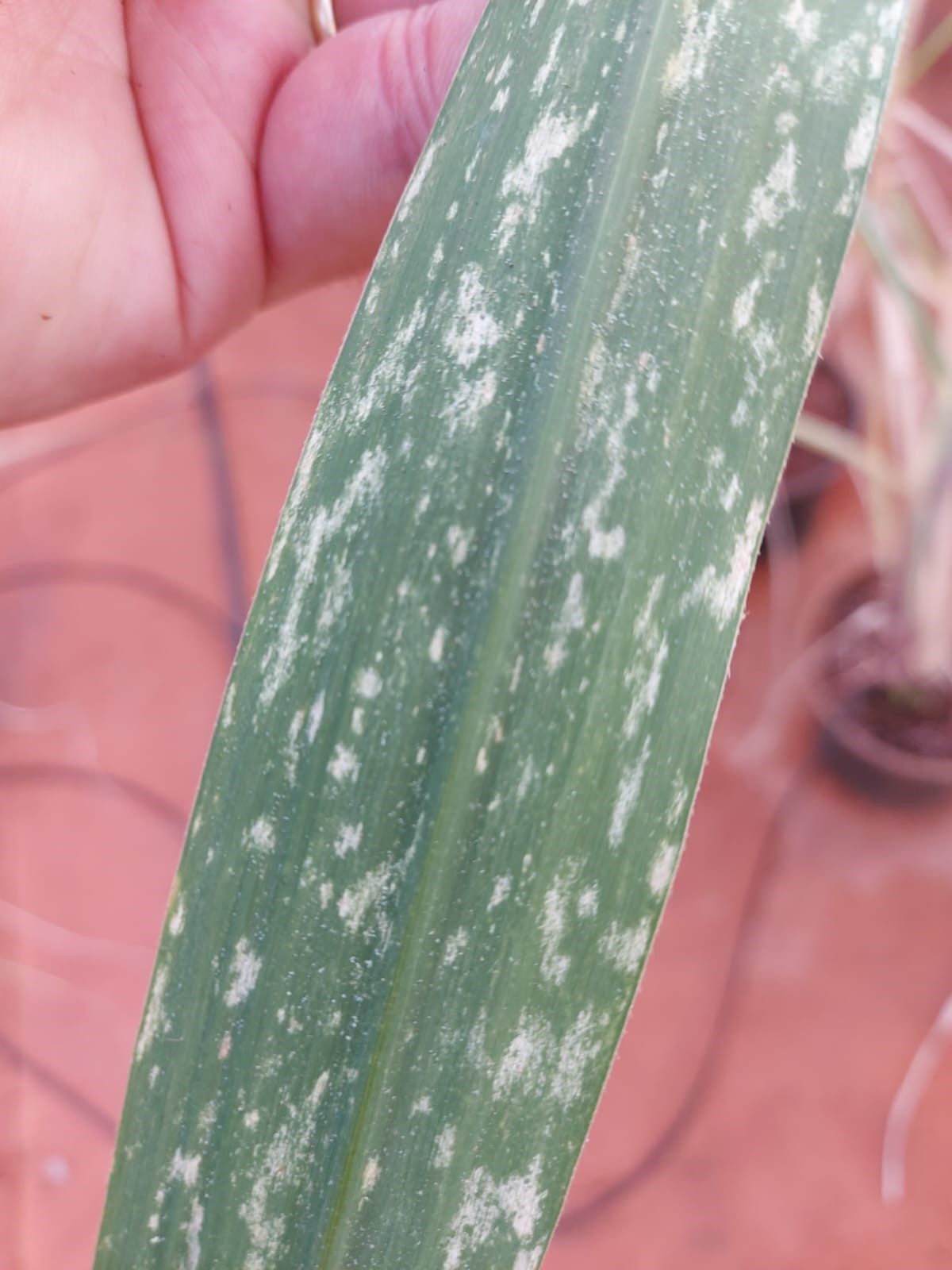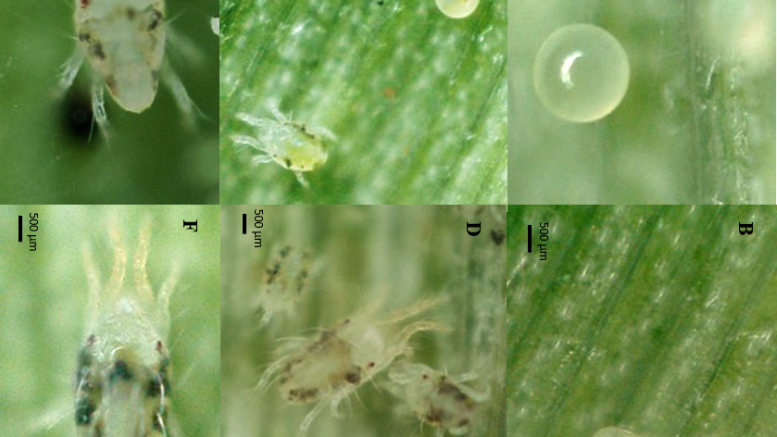“…the species S. sacharum has been reported more frequently in recent decades in sugarcane farms…”
Daniel Júnior de Andrade is a professor at São Paulo State University – Unesp, coordinator of AcaroLab – Acarology Laboratory, has a degree in agronomy and a Ph.D. in entomology and acarology from Unesp.
Gabriel Ramos is a graduate student in agronomic engineering at São Paulo State University – Unesp, an intern with scholarship from the acarology sector at Unesp.

Daniel de Andrade, professor at Unesp
AgriBrasilis – Are mites on sugarcane a cause for concern?
Andrade e Ramos – At the moment there is no reason to despair about the occurrence of pest mites in sugarcane. However, due to recent changes in crop management, as well as climate change experienced in recent decades, mite outbreaks are expected to increase. Therefore, it is essential to invest in research for a better understanding of these organisms in the crop. Such research can ensure support for more efficient and lower-cost management strategies.
AgriBrasilis – What are the main species of phytophagous mites that occur in Brazilian sugarcane farms?
Andrade e Ramos – Several species of phytophagous mites occur in sugarcane in Brazil. We can mention: Abacarus sacchari, Steneotarsonemus bancrofti, Monoceronychus linki, Schizotetranychus sacharum e Oligonychus grypus. However, the species S. sacharum has been reported more frequently in recent decades in sugarcane farms in Brazil. This species has already been reported in the States of São Paulo, Rio de Janeiro, Paraná and Mato Grosso do Sul. In the State of São Paulo, it has been found with some frequency in the regions of Ribeirão Preto, Jaboticabal and Piracicaba, cities that have great prominence in the sugar-ethanol sector.

Gabriel Ramos, agronomic engineering student at Unesp
AgriBrasilis – Is the biological cycle of S. sacharum similar to the cycle of other tetranychid mites? Besides to sugarcane, does this mite infest other plant species?
Andrade e Ramos – Yes, the biological cycle of the S. sacharum is very similar to that of other tetranychids. During biological development, S. sacharum goes through the stages of egg, larva, protonymph, deutonymph and adult (females and males).
Preliminary results by Ramos (2023) showed that the egg, larva, protonymph, and deutonymph stages have an average duration of 6.3, 1.9, 3.1, and 4.2 days, respectively. Therefore, the duration of the biological cycle (egg to adult) is approximately 9.3 days. Females have an average longevity of 18.6 days and fecundity of 9.4 eggs (eggs/female).
Regarding the second question, so far it is known that the S. sacharum infests only sugarcane. However, this has not yet been adequately studied and there may be other host plants.

Foliar symptoms caused by S. sacharum
AgriBrasilis – How can S. sacharum be recognized in the farm? What are the symptoms and possible damage caused by this species?
Andrade e Ramos – The S. sacharum mite always infests the lower surface of the leaves (abaxial), preferably along the central and secondary veins. In addition to the characteristic greenish coloration, the mite can be recognized by the X-shaped webs it makes on the abaxial surface of the leaves.
High infestations of this mite cause the appearance of brown, reddish or purplish streaks along the veins, which leads to leaf dryness.
Research results have indicated that this species is able to reduce stem diameter, fiber percentage, and even total reducing sugars (TRS).
More details in Silva (2021)

X-shaped webs omade by S. sacharum
AgriBrasilis – What factors can explain the sudden increase in S. sacharum populations?
Andrade e Ramos – Several factors can explain these population outbreaks: the prohibition of fires, the excessive use of pesticides (mainly insecticides), inadequate fertilization (mainly nitrogen), planting of varieties more susceptible to mites, climate change, among other factors still unknown.
“S. sacharum always infests the lower surface of the leaves (abaxial), preferably along the central and secondary veins”
AgriBrasilis – Has this mite ever been found in farms of pre-sprouted seedlings (PSS)?
Andrade e Ramos – Yes. Farm surveys carried out by Silva and Andrade (2022) in nurseries near Ribeirão Preto, State of São Paulo, revealed the existence of the mite in nurseries for the production of pre-sprouted seedlings. S. sacharum was found in 13 varieties of sugarcane: RB975992, CTC22994, CT013377, RB975775, RB995198, RB925279, IACSP911099, CTC20, RB987935, RB867515, IACSP955094, IACC1C52562, CV7870.
These results caused concern, as the mite could be spreading through the seedlings. The good news is that in 2023 new surveys were carried out in the nurseries and S. sacharum mites were not found anymore. After the results of the research, there were improvements in the process of sanitizing the seedlings, which explains why the mite was no longer found.
More details in Silva e Andrade (2022)
AgriBrasilis – Can the symptoms and damage caused by S. sacharum be confused with symptoms caused by other mites?
Andrade e Ramos – Yes, they can. The initial symptoms of the attack of S. sacharum can be confused with the attack of the tetranychid Oligonychus grypus, known as the African sugarcane mite, first reported in poaceae plants [grasses] in East Africa.
Initially both lesions are presented by small whitish spots on the leaves, with the evolution of symptoms it is possible to differentiate the damage caused by the two types of mites. Over time, the lesions caused by S. sacharum resemble reddish streaks due to the oxidation of plant tissue. The lesions caused by the African sugarcane mite, when evolved, present a yellowish to whitish “mottling” along the leaf blade.

Foliar symptoms caused by Oligonychus grypus
AgriBrasilis – Are there acaricides registered by the Ministry of Agriculture of Brazil for the control of this species? How should S. sacharum be managed?
Andrade e Ramos – Unlike other crops, such as citrus and soybean, which constantly suffer from the attack of pest mites, MAPA has not yet registered any acaricide for the control of S. sacharum.
As for management, knowledge about the species and its potential for damage is quite limited. Therefore, it is strongly recommended to use healthy seedlings free of pest mites. In addition, the farmer must be aware of the exaggerated use of insecticides and fertilizers, which can trigger outbreaks of the mite.
As for the variety to be chosen, there is still no information about the existence of resistant varieties. In areas heavily infested with the mite, it is sometimes necessary to use biological acaricides based on entomopathogenic fungi, with the aim of reducing infestations.
READ MORE:

